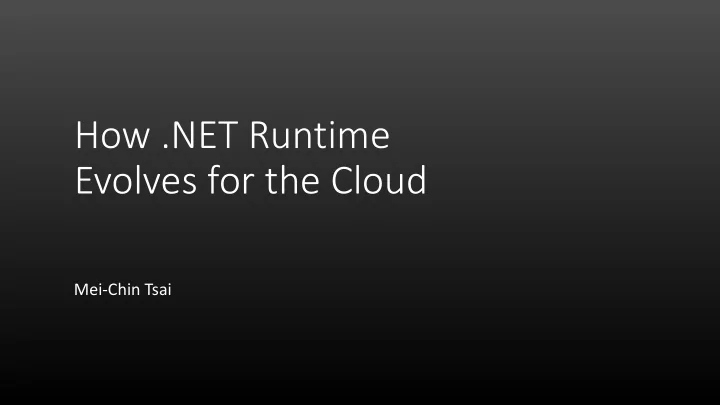

How .NET Runtime Evolves for the Cloud Mei-Chin Tsai
Workload such as Exchange, Bing Workload such as Lambda or Functions App App App App Container Container Container Container Monolithic Application Virtual Machine Virtual Machine Host OS Host OS Physical Server Physical Server
• Number of available CPU cores Physical • Number of threads resources that • Number of managed heaps • Size of available memory impact • Heap size Runtime • Number of heaps • Others heuristics
• .NET GCs are generational • Two different flavors of GCs today • Workstation GC • One managed heap (one GC thread) .NET GCs • Server GC • N managed heaps and N GC threads
Server GC Workstation GC one GC heap per core one heap for all Core 1 Core 2 Core 3 Core 4 Core 1 Core 2 Core 3 Core 4 Heap 1 Heap 2 Heap 3 Heap 4 Heap
Use multi-pronged approach for scaling Runtime Application/Process Application Runtime Configuration Using less Allow application memory is Scale down Scale up to specify intent generally better Optimize for Docker support many-core chip architecture
• Reduce the initial commit size of gen 0 Using less • Reduce the initial gen 0 allocation budget to better align with modern cache size and cache hierarchy memory ry is • New policy to determine number of GC heaps to create based on memory limit generally • Example – • Application memory limit is 160MB, default better – less GC memory segment per heap is 16MB • Old behavior: allocating one heap per core memory ry by on 48 core machine exceeds limit • New behavior: allocate 10 heaps, meets default limit
TechEmpower benchmarks ~50% of committed memory reduction
• Memory limit set on container • docker run -m 100mb -t xxx • GC heap is not the only component use memory. Scale down – • Introducing GCHeapHardLimit config • GCHeapHardLimit - specifies a hard limit for the GC Docker heap • GCHeapHardLimitPercent - specifies a percentage of container the physical memory this process is allowed to use • If neither is specified but the process is running inside a support container with a memory limit specified, we will take this as the hard limit: • max (20mb, 75% of the memory limit on the container)
• Observation - Bing frontend observed many TLB misses in their workload latency • Add an application config to allow large page Allow support application to • Pay more cost on each new page load request but hope to pay less frequently specify fy intent • On Windows – Runtime commit all the - Larg rge pages managed memory upfront. • Does change application performance support characteristic • Use carefully
Bing frontend (SNR) – P95 improvement ~108ms -> ~88ms (18.5% improvement). 50 th %ile (average), the improvement was around 9%
Trend is to use more cores (many of our customers are on 32 to 48 cores and are looking to upgrade core count) E.g. AMD ROME CPU – 64 cores, NUMA Scale Up – many-core processors The heap balancing mechanism needed to be revisited
Server GC one GC heap per core Each heap maintains its gen0 budget (ie, allocations it allows before triggering the next GC) Core 1 Core 2 Core 3 Core 4 • when any heap’s budget is exceeded, a GC pass is triggered • When GC is triggered, the whole world is stopped Heap 1 Heap 2 Heap 3 Heap 4 Memory in use
• When allocations on threads are balanced, they should stay allocating on the same heap • When allocations on threads are Heap unbalanced, they should in general spread evenly across heaps balancing goal • But there are special considerations, eg, we should favor the heap for that core
Current heap balancing mechanism explained • Home and alloc heap • Local heaps (on current NUMA node) vs remote heaps • Look at local heaps first • Requires a large delta to balance to a remote heap • When allocating to a remote heap, we incur not just remote allocation cost. We also incur remote access cost in the future. • Problem – we are trying too hard to keep heaps well balanced • Not showing up as problems when you had fewer heaps to search • The cost of remote access cannot be easily factored in ahead of time
Realizations • If we do less work and still achieve similar fill ratios, we should do that instead of looking at each heap • Balancing on earlier allocations is less important than later ones which tend to survive more
Thoughts • Really need better tooling to help with the investigation • vtune does show many memory counters but they can be hard to interpret; we also want to correlate with GC activities • New GC specific tooling shows how threads and their alloc heaps migrate Show the heap/thread logs of runtime instrumentation
Q/A
Recommend
More recommend